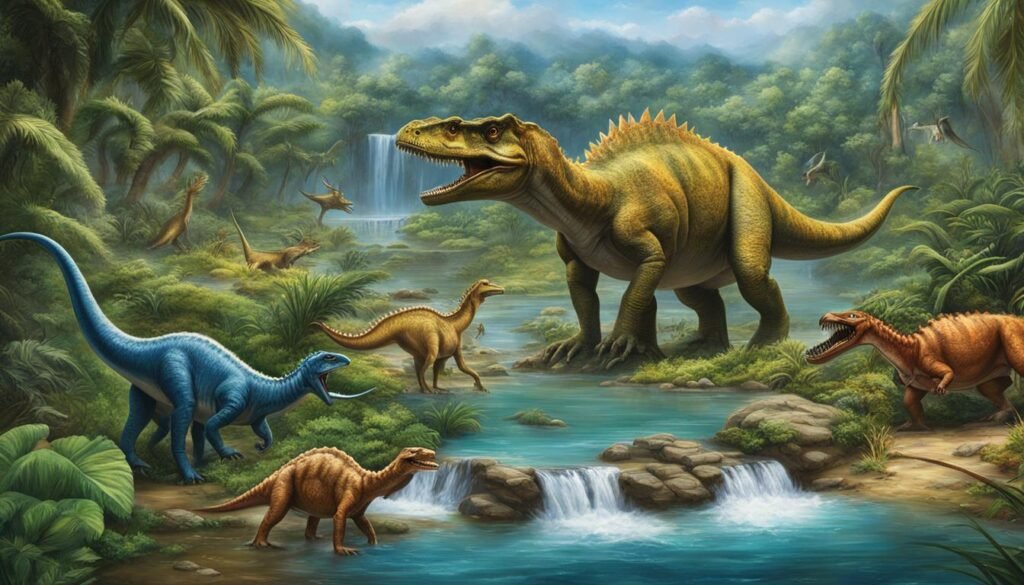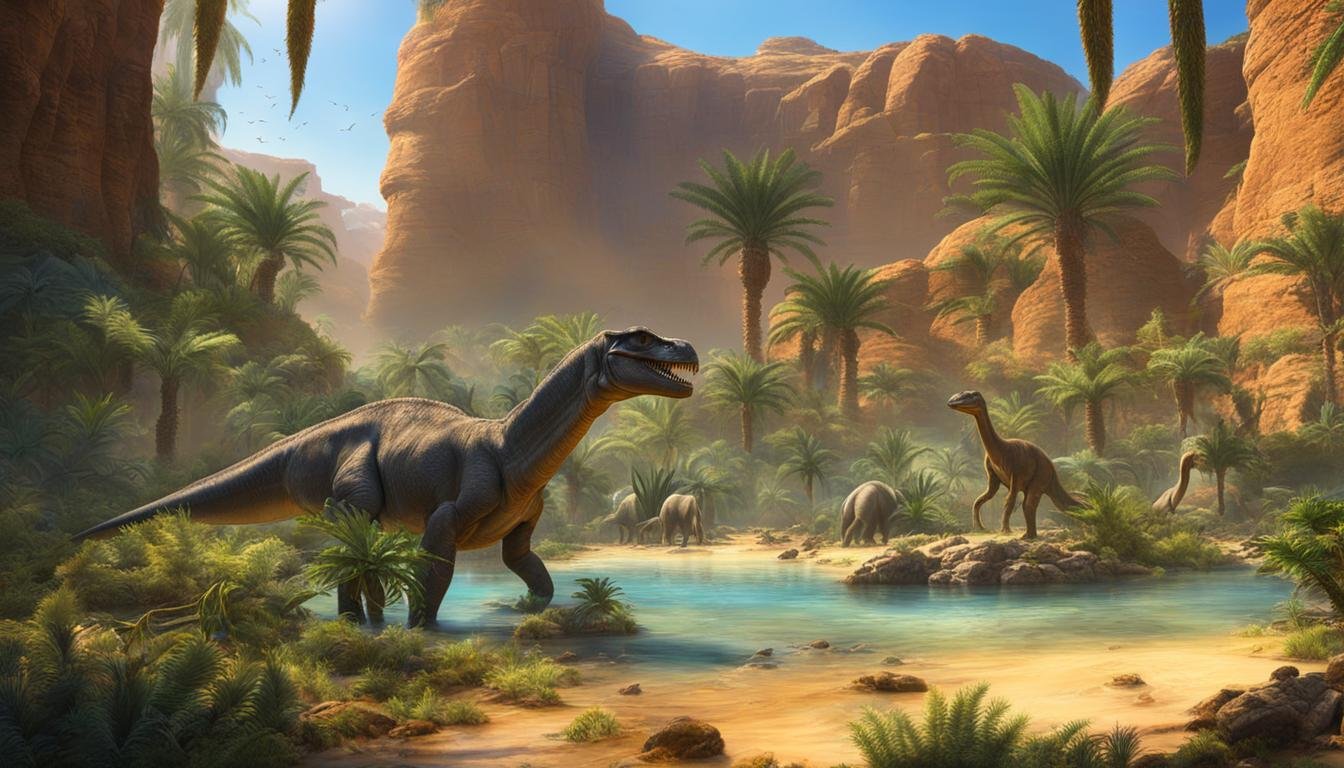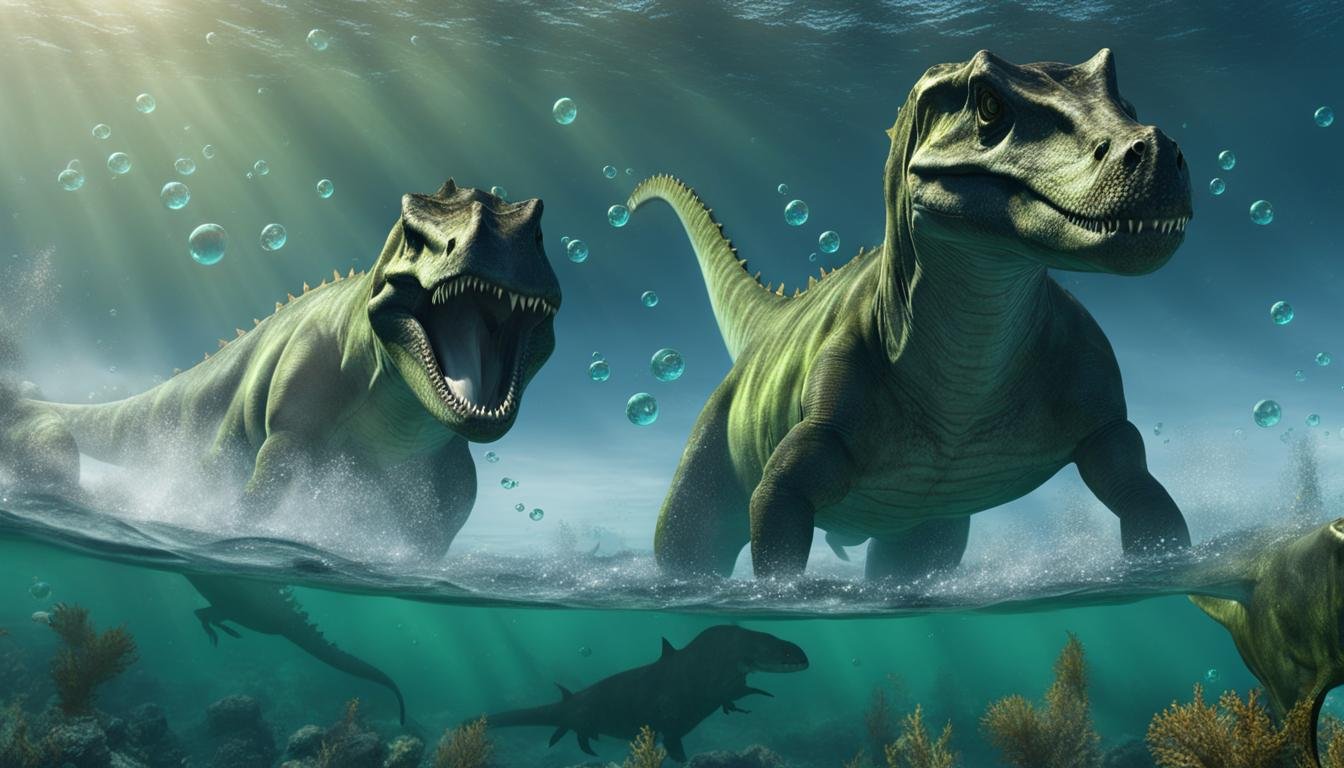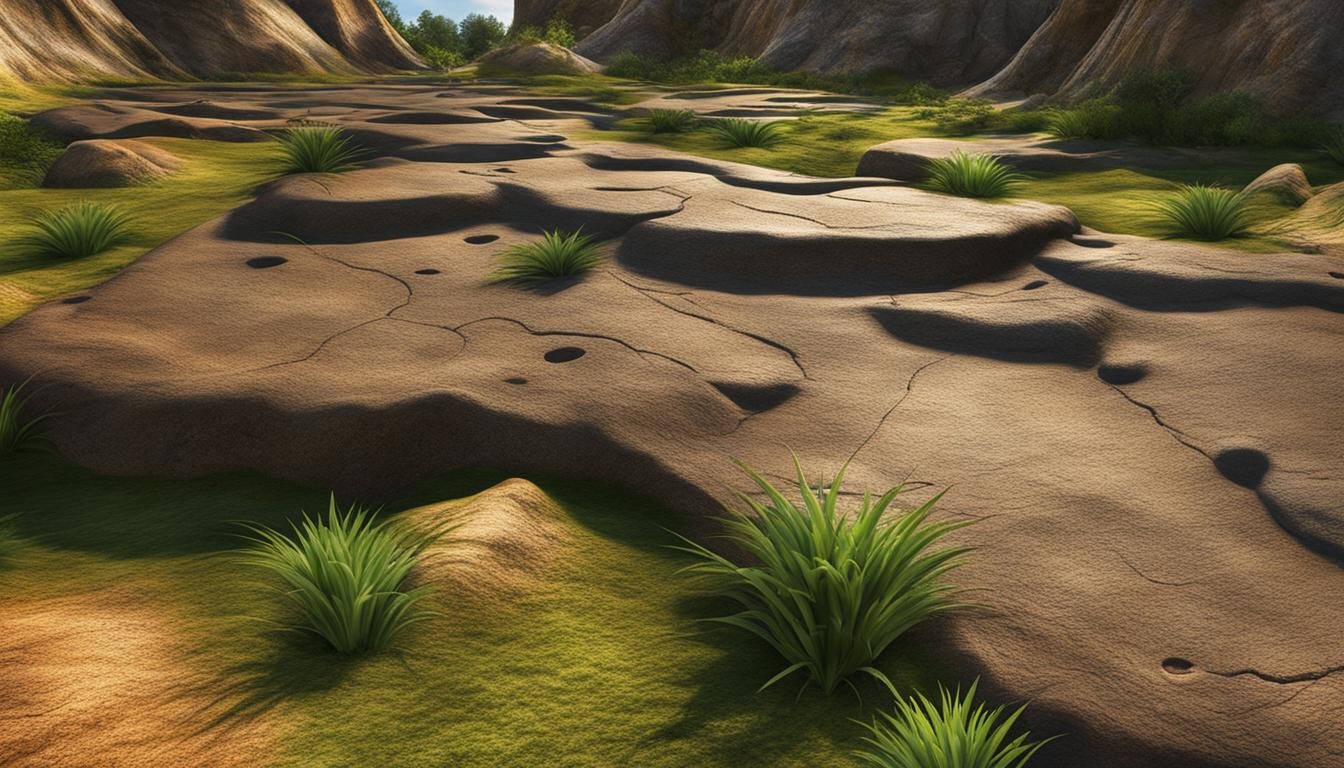Experts have explored the water needs of dinosaurs and how they thrived in ancient environments. Let’s dive into the fascinating world of dinosaur water consumption and their adaptation to a world without modern conveniences.
| Main Point | Description |
|---|---|
| Dependence on Water Sources | Dinosaurs heavily relied on various water sources for their sustenance in ancient landscapes. |
| Water’s Role in Dinosaur Physiology | Water was crucial for dinosaurs, aiding in digestion, temperature regulation, and blood circulation. |
| Influence on Behavior and Migration | The quest for water significantly influenced dinosaur behavior, including their migration patterns and daily activities. |
| Variability in Water Consumption | The amount of water dinosaurs consumed varied based on their size, diet, and the environmental conditions they lived in. |
| Estimating Dinosaur Hydration Needs | Scientific techniques are employed to estimate the water intake of dinosaurs, providing insights into their hydration requirements. |
The Physiology of Dinosaurs and Water Importance
Dinosaurs were remarkable creatures that roamed the Earth millions of years ago. Their physiological characteristics and adaptation to their habitats played a crucial role in their survival. One key aspect of their physiology was their water consumption and the importance of water in their daily lives.
Dinosaurs had robust bodies and skeletal structures that required substantial amounts of water to support their massive size. Water played a vital role in several physiological processes, including digestion, temperature regulation, and circulation. It helped break down food, aid in nutrient absorption, and eliminate waste products, ensuring efficient digestion and metabolism.
“Water is a critical component for any living organism, and dinosaurs were no exception,” says Dr. Jane Thompson, paleontologist and dinosaur expert. It was not only essential for their physiological functions but also influenced their behavior and habitat selection.”
The adaptability of dinosaurs to different environments was closely linked to their ability to find and utilize water sources. Some species relied on permanent water bodies like rivers and lakes, while others adapted to survive in more unpredictable or seasonal water sources. The availability of water dictated their behavior, migration patterns, and overall survival strategies.
| Dinosaur Species | Preferred Water Sources | Adaptations |
|---|---|---|
| Tyrannosaurus rex | Rivers and lakes | Large size and powerful limbs for efficient movement to access water sources |
| Stegosaurus | Seasonal rivers and temporary pools | Plates on their backs may have helped regulate body temperature and reduce water loss |
| Brachiosaurus | Permanent lakes and water-rich habitats | Long necks and elevated feeding positions to access vegetation near water bodies |
Dinosaur Adaptability to Water Availability
The diverse range of dinosaurs and their adaptability to different water sources provide valuable insights into their survival strategies. Understanding their physiology and water needs helps us comprehend the remarkable ways in which these ancient creatures thrived in their habitats.
Challenges of Sourcing Water in Ancient Landscapes
As dinosaurs roamed the Earth millions of years ago, they faced numerous challenges in finding and accessing water sources in ancient landscapes. The availability of water played a crucial role in their survival strategies, shaping their behavior and migration patterns. Let’s explore the fascinating world of prehistoric water sources and dinosaur survival strategies.
Some dinosaur species relied on permanent water bodies such as rivers and lakes to meet their hydration needs. These water sources provided a consistent supply of water and were often home to abundant plant and animal life. Other dinosaurs, however, had to adapt to survive in more seasonal or ephemeral water sources.
Competition for water resources was fierce among dinosaurs, leading to territorial conflicts and the need to balance hydration with the risks of venturing into unfamiliar territories. The ability to locate and secure water sources played a critical role in their survival. Dinosaurs were highly adaptable and displayed remarkable intelligence in navigating their environments to find water, even in the harshest of conditions.
| Dinosaur Species | Water Source |
|---|---|
| Tyrannosaurus Rex | Permanent water bodies: rivers and lakes |
| Stegosaurus | Seasonal water sources: temporary rivers and ponds |
| Triceratops | Ephemeral water sources: rainwater puddles and natural depressions |
Understanding the challenges dinosaurs faced in sourcing water provides valuable insights into their ability to adapt and survive in ancient environments. It also highlights the importance of water availability in shaping the evolution and behavior of these magnificent creatures.
Factors Affecting Dinosaur Water Consumption
Dinosaur water intake was influenced by several key factors, which played a crucial role in their hydration needs and overall survival. These factors shed light on the intricate balance between the massive size of dinosaurs, their metabolic needs, and the availability of water sources in their ancient environments.
One significant factor was the size and weight of the dinosaurs themselves. Larger dinosaurs had higher water intake requirements due to their massive bodies and increased metabolic functions. This meant they needed more water to support digestion, maintain proper temperature regulation, and facilitate circulation throughout their extensive skeletal structures.
The diet of dinosaurs also affected their water consumption. Herbivorous dinosaurs consumed vast quantities of vegetation, which required ample amounts of water for efficient digestion. The plant matter they consumed contained cellulose, a complex carbohydrate that is challenging to break down. Consequently, herbivorous dinosaurs needed to drink more water to aid in the digestion process.
“Dinosaur water intake was influenced by their size, weight, and diet, as well as the availability of water sources in their ancient environments.”
Additionally, the environment in which dinosaurs lived played a crucial role in their hydration needs. The availability of water sources and the climate of their habitats greatly impacted the amount of water dinosaurs required. Some dinosaurs lived in regions with abundant permanent water bodies, such as rivers and lakes, making hydration more accessible. Others had to adapt to survive in regions with more seasonal or ephemeral water sources, which necessitated behavioral and migratory patterns to ensure they could stay adequately hydrated.
In summary, dinosaur water consumption was influenced by factors such as their size, weight, diet, and the availability of water sources in their ancient environments. Larger dinosaurs with higher metabolic needs required more water for digestion, temperature regulation, and circulation. Herbivorous dinosaurs needed additional water to aid in digesting the vast quantities of vegetation they consumed. The availability of water sources and the climate of their habitats also played a significant role in their hydration needs, shaping their behavior and migration patterns.
| Factors | Influence on Dinosaur Water Intake |
|---|---|
| Size and Weight | Higher intake due to larger bodies and increased metabolic needs |
| Diet | Herbivorous dinosaurs consumed more water to aid in digestion |
| Environment | Availability of water sources and climate impacted hydration needs |
Dinosaur Water Consumption: Estimating Water Intake
Dinosaurs, with their massive bodies and high metabolic rates, required significant amounts of water to survive and thrive in ancient environments. Estimating dinosaur water intake can provide valuable insights into their hydration needs and how they adapted to the challenges of finding water sources. Scientists employ various methods to estimate dinosaur water consumption, shedding light on their relationship with water and the environment they inhabited.
One method used to estimate dinosaur water intake is oxygen isotope analysis. By analyzing the ratio of oxygen isotopes in fossilized dinosaur teeth or bones, researchers can determine the composition of the water the dinosaurs consumed. This analysis provides insights into their hydration needs and the types of water sources they relied on. Comparisons with modern animals, like elephants and hippos, can also help in understanding dinosaur water requirements.
Another approach to estimating dinosaur water intake is body mass scaling. By comparing the body mass of a dinosaur with that of a modern animal of similar size, researchers can estimate the water intake needed to support the larger dinosaur’s metabolism. This method takes into account the relationship between body mass and metabolic rate, providing valuable insights into dinosaur hydration needs.
| Dinosaur Species | Estimated Water Intake (Liters/Day) |
|---|---|
| Tyrannosaurus Rex | 500 |
| Triceratops | 200 |
| Stegosaurus | 100 |
The table above showcases estimated water intake for different dinosaur species. These estimations are based on a combination of oxygen isotope analysis, body mass scaling, and comparisons with modern animals. It’s important to note that these values are approximations, and actual water intake may have varied depending on factors such as diet, environment, and individual metabolism.
Understanding dinosaur water consumption provides valuable insights into their ability to adapt and survive in ancient environments. It highlights the challenges they faced in finding water sources and how they developed strategies to meet their hydration needs. By unraveling the mysteries of dinosaur water intake, scientists continue to uncover fascinating details about these magnificent creatures and the world they inhabited.
Ancient Climate and Dinosaur Survival
Dinosaurs lived in various ancient climates, ranging from tropical to polar regions. These prehistoric environments played a crucial role in shaping the survival strategies of these magnificent creatures. Understanding how dinosaurs adapted to changing climates can provide valuable insights into their resilience and ability to thrive in diverse ecosystems.
During the Mesozoic Era, the Earth experienced significant climate fluctuations. While some periods were relatively stable, others saw dramatic shifts with periods of rapid warming or cooling. Dinosaurs faced the challenge of adapting to these changing conditions to ensure their survival.
Scientists have studied paleoclimatic data to reconstruct ancient climate patterns at different timescales. This research has revealed that the Mesozoic Era featured a greenhouse climate, characterized by higher carbon dioxide levels and warmer temperatures than today. These conditions influenced the distribution of plants and animals, including dinosaurs, and shaped their habitat availability and food sources.
Understanding how dinosaurs adapted to changing climates can provide valuable insights into their resilience and ability to thrive in diverse ecosystems.
| Ancient Climate Types | Main Characteristics |
|---|---|
| Tropical | High temperatures, abundant rainfall, lush vegetation |
| Subtropical | Warm temperatures, seasonal rainfall, diverse ecosystems |
| Temperate | Moderate temperatures, distinct seasons, deciduous forests |
| Polar | Cold temperatures, low precipitation, polar ice caps |
Dinosaurs adapted to these ancient climates by developing various physiological and behavioral strategies. Some dinosaurs had specific adaptations to cope with extreme temperatures, such as insulation or large nasal passages to warm or cool the air they breathed. Others migrated to more favorable environments during harsh seasons, following the availability of food and water sources.
By studying the interactions between dinosaurs and ancient climate, scientists gain a deeper understanding of the complex dynamics that allowed these creatures to thrive for millions of years. This knowledge not only sheds light on the past but also provides valuable insights into how current and future ecosystems may respond to ongoing climate changes.

Conclusion
Dinosaurs, despite their massive size and the challenges they faced in finding water, were able to adapt and survive in ancient environments. Understanding their water needs provides valuable insights into their survival strategies and interactions with the prehistoric world. The study of dinosaur water consumption contributes to our understanding of these magnificent creatures and the environments they thrived in.
As we delve into the past, we uncover the remarkable adaptability of dinosaurs to a world without modern conveniences. Despite the scarcity of water sources and the changing climate, these extinct species managed to navigate their prehistoric environment. Their physiological adaptations and behavioral strategies enabled them to thrive in diverse landscapes and face the unpredictable challenges of survival.
Exploring their water intake also helps us draw parallels with modern-day animals and their ecological requirements. By estimating dinosaur water consumption, scientists gain further insights into the complex interactions between ancient ecosystems and the creatures that inhabited them. This information allows us to piece together the puzzle of Earth’s prehistoric past and appreciate the remarkable resilience of these long-extinct species.









